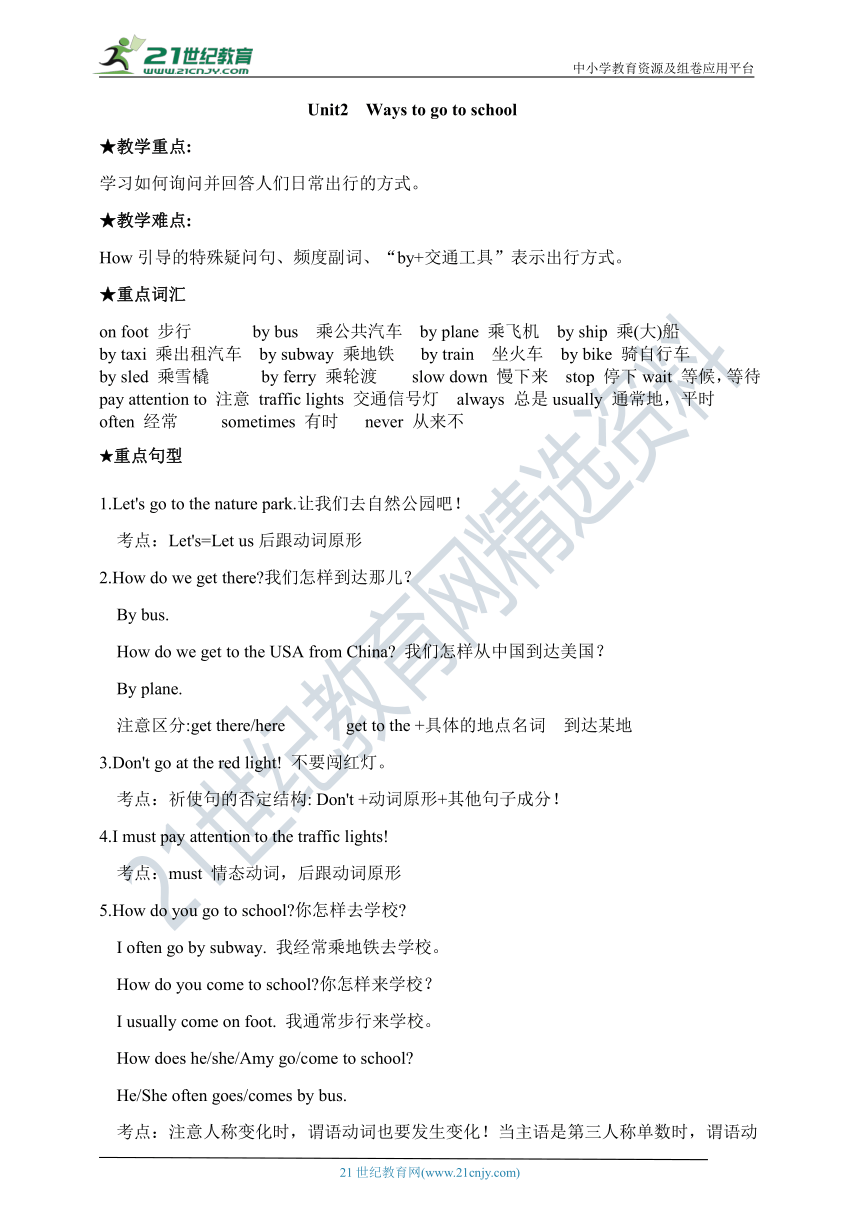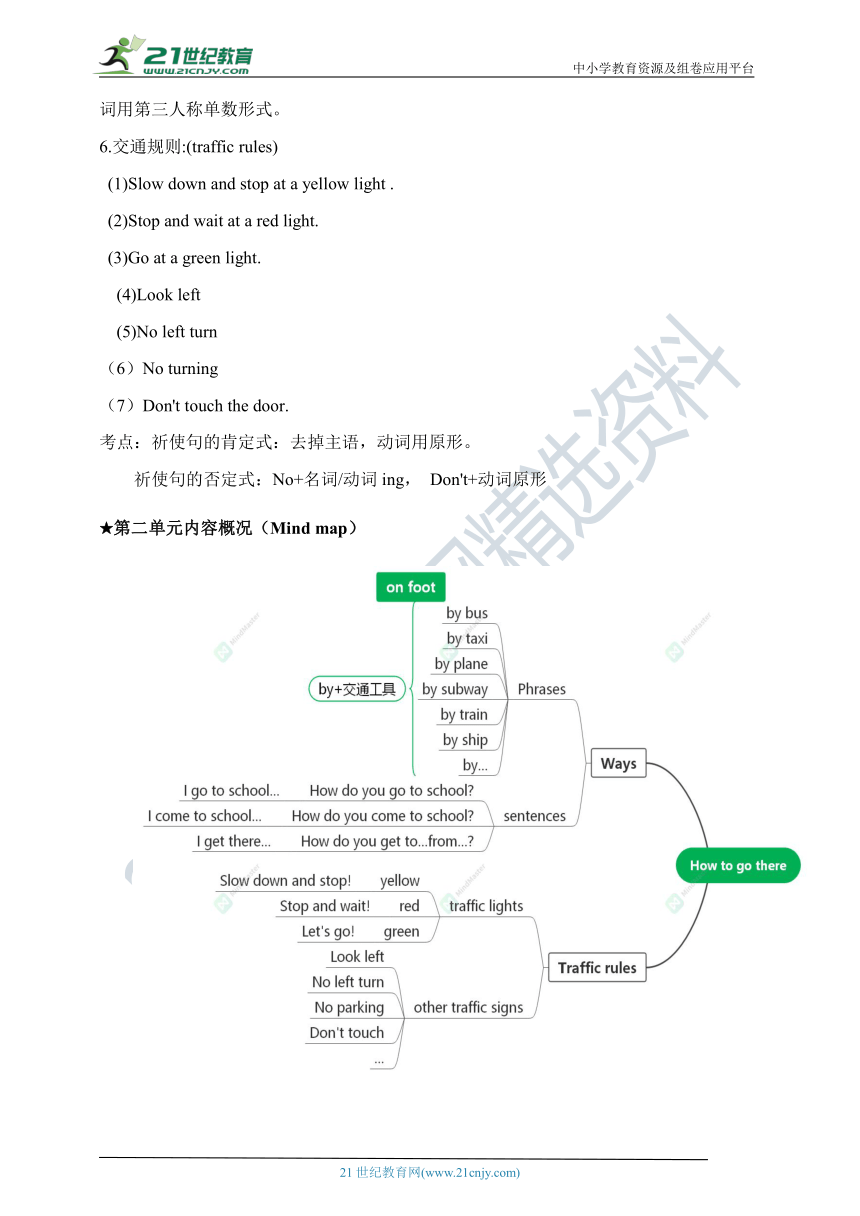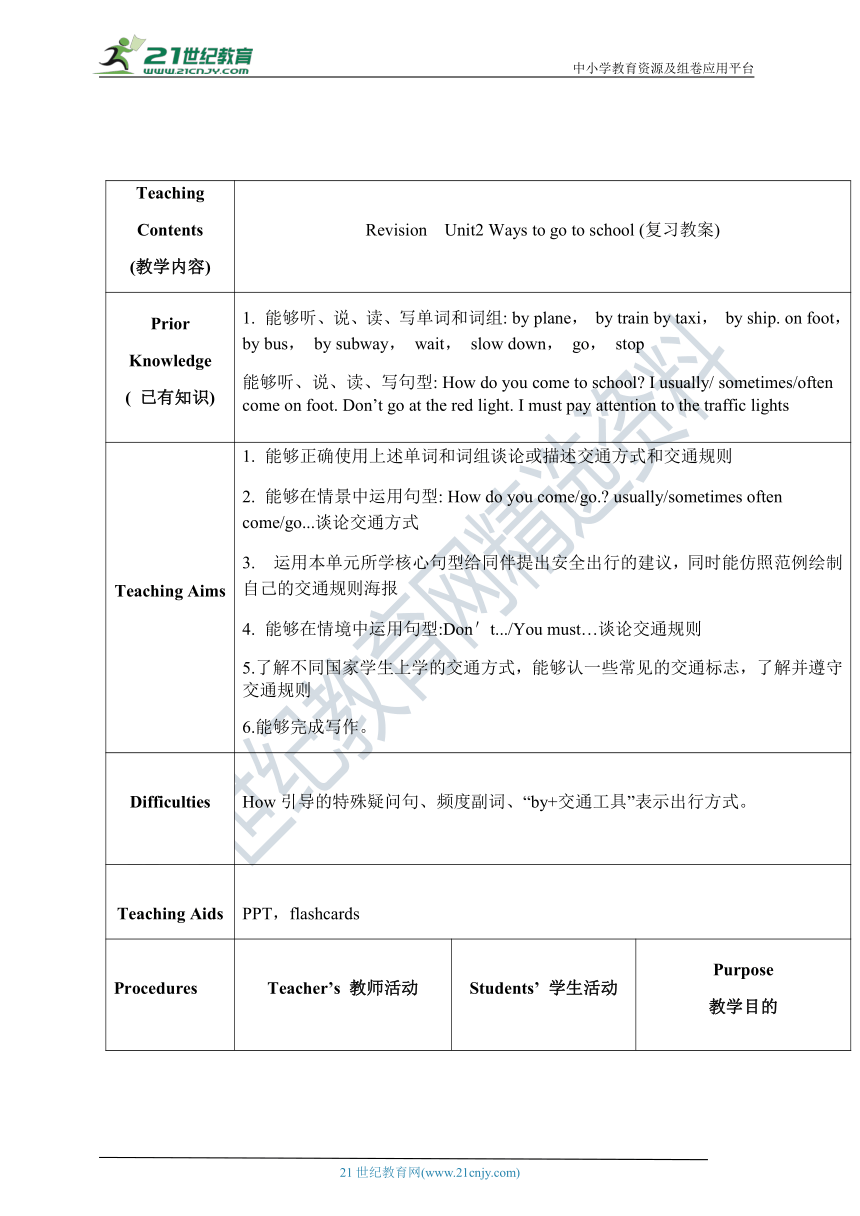Unit2 Ways to go to school 单元复习教案+单元思维导图+知识点总结
文档属性
| 名称 | Unit2 Ways to go to school 单元复习教案+单元思维导图+知识点总结 |  | |
| 格式 | doc | ||
| 文件大小 | 1.4MB | ||
| 资源类型 | 试卷 | ||
| 版本资源 | 人教版(PEP) | ||
| 科目 | 英语 | ||
| 更新时间 | 2022-07-27 11:10:30 | ||
图片预览



文档简介
中小学教育资源及组卷应用平台
Unit2 Ways to go to school
★教学重点:
学习如何询问并回答人们日常出行的方式。
★教学难点:
How引导的特殊疑问句、频度副词、“by+交通工具”表示出行方式。
★重点词汇
on foot 步行 by bus 乘公共汽车 by plane 乘飞机 by ship 乘(大)船 by taxi 乘出租汽车 by subway 乘地铁 by train 坐火车 by bike 骑自行车 by sled 乘雪橇 by ferry 乘轮渡 slow down 慢下来 stop 停下wait 等候,等待
pay attention to 注意 traffic lights 交通信号灯 always 总是usually 通常地,平时 often 经常 sometimes 有时 never 从来不
★重点句型
1.Let's go to the nature park.让我们去自然公园吧!
考点:Let's=Let us后跟动词原形
2.How do we get there 我们怎样到达那儿?
By bus.
How do we get to the USA from China 我们怎样从中国到达美国?
By plane.
注意区分:get there/here get to the +具体的地点名词 到达某地
3.Don't go at the red light! 不要闯红灯。
考点:祈使句的否定结构: Don't +动词原形+其他句子成分!
4.I must pay attention to the traffic lights!
考点:must 情态动词,后跟动词原形
5.How do you go to school 你怎样去学校
I often go by subway. 我经常乘地铁去学校。
How do you come to school 你怎样来学校?
I usually come on foot. 我通常步行来学校。
How does he/she/Amy go/come to school
He/She often goes/comes by bus.
考点:注意人称变化时,谓语动词也要发生变化!当主语是第三人称单数时,谓语动词用第三人称单数形式。
6.交通规则:(traffic rules)
(1)Slow down and stop at a yellow light .
(2)Stop and wait at a red light.
(3)Go at a green light.
(4)Look left
(5)No left turn
(6)No turning
(7)Don't touch the door.
考点:祈使句的肯定式:去掉主语,动词用原形。
祈使句的否定式:No+名词/动词ing, Don't+动词原形
★第二单元内容概况(Mind map)
TeachingContents(教学内容) Revision Unit2 Ways to go to school (复习教案)
PriorKnowledge( 已有知识) 能够听、说、读、写单词和词组: by plane, by train by taxi, by ship. on foot, by bus, by subway, wait, slow down, go, stop 能够听、说、读、写句型: How do you come to school I usually/ sometimes/often come on foot. Don’t go at the red light. I must pay attention to the traffic lights
Teaching Aims 能够正确使用上述单词和词组谈论或描述交通方式和交通规则能够在情景中运用句型: How do you come/go. usually/sometimes often come/go...谈论交通方式 运用本单元所学核心句型给同伴提出安全出行的建议,同时能仿照范例绘制自己的交通规则海报能够在情境中运用句型:Don't.../You must…谈论交通规则 5.了解不同国家学生上学的交通方式,能够认一些常见的交通标志,了解并遵守交通规则6.能够完成写作。
Difficulties How引导的特殊疑问句、频度副词、“by+交通工具”表示出行方式。
Teaching Aids PPT,flashcards
Procedures Teacher’s 教师活动 Students’ 学生活动 Purpose教学目的
Warm up Listen a song:How do you get there Talk about means of transportation in the video 师生问答,拉近师生间的距离,并复习旧知识,为新课学习预热做准备。
Lead in Show a map of ChinaTeacher:Which city do you want to go in your holiday And how will you go there Students talk about favourite city,and review the vocabularies about ways. 创设情境,趣味导入。通过看图,听老师讲解,看到熟悉的map, 找自己喜欢或向往的城市,引起学生的求知欲,并引入新课文的学习。
Presentation Show a mind mapBrain Storm2.T plays a videoT: When we go outside, we have many ways to go to many places. What are they Let’s watch.3.T: It’s so nice to have so many ways to travel. But we must know about many traffic signs and rules in different places or countries.How many traffic signs or rules do you know What are they 4.Read and fill Show the two dialogues from our book, but some words or sentences are missing. Ask Ss to fill in the blanks.Then make new dialogues5.Look the map of our city/town/village, Choose one place and describe how you go there and what you should pay attention to. Ss say the ways in our daily life2.Ss watch and write down the ways that we see from the video.3.Ss talk in groups, know the same and difference of traffic rules between China and foreign.4.Ask Ss to make new dialogues, Work in pairs and act6. Ask Ss look , talk and report.ass 通过问答、头脑风暴、看视频、改编对话、完成任务等训练活动,步步推进复习教学。在教学过程中,精心设计环节,提高趣味性,并让学生不断思考。在任务完成的过程中,层层推进复习的难度和深度,帮助学生复习熟练掌握词汇和句型,并在操练过程中巩固本单元的核心词汇和句型。最后,通过图片解读和教师的讲解,学生能基本了解本单元主要内容。
Consolidation Let’s write.Describe one place in your city/town/village, and describe describe how you go there and what you should pay attention to. Ask Ss to write a passage about ways and rules 通过写一写检查学生的输出。
Homework 1.Try to recite the text.2.Writing:The traffic rules that we know on the way to school
21世纪教育网 www.21cnjy.com 精品试卷·第 2 页 (共 2 页)
HYPERLINK "http://21世纪教育网(www.21cnjy.com)
" 21世纪教育网(www.21cnjy.com)
Unit2 Ways to go to school
★教学重点:
学习如何询问并回答人们日常出行的方式。
★教学难点:
How引导的特殊疑问句、频度副词、“by+交通工具”表示出行方式。
★重点词汇
on foot 步行 by bus 乘公共汽车 by plane 乘飞机 by ship 乘(大)船 by taxi 乘出租汽车 by subway 乘地铁 by train 坐火车 by bike 骑自行车 by sled 乘雪橇 by ferry 乘轮渡 slow down 慢下来 stop 停下wait 等候,等待
pay attention to 注意 traffic lights 交通信号灯 always 总是usually 通常地,平时 often 经常 sometimes 有时 never 从来不
★重点句型
1.Let's go to the nature park.让我们去自然公园吧!
考点:Let's=Let us后跟动词原形
2.How do we get there 我们怎样到达那儿?
By bus.
How do we get to the USA from China 我们怎样从中国到达美国?
By plane.
注意区分:get there/here get to the +具体的地点名词 到达某地
3.Don't go at the red light! 不要闯红灯。
考点:祈使句的否定结构: Don't +动词原形+其他句子成分!
4.I must pay attention to the traffic lights!
考点:must 情态动词,后跟动词原形
5.How do you go to school 你怎样去学校
I often go by subway. 我经常乘地铁去学校。
How do you come to school 你怎样来学校?
I usually come on foot. 我通常步行来学校。
How does he/she/Amy go/come to school
He/She often goes/comes by bus.
考点:注意人称变化时,谓语动词也要发生变化!当主语是第三人称单数时,谓语动词用第三人称单数形式。
6.交通规则:(traffic rules)
(1)Slow down and stop at a yellow light .
(2)Stop and wait at a red light.
(3)Go at a green light.
(4)Look left
(5)No left turn
(6)No turning
(7)Don't touch the door.
考点:祈使句的肯定式:去掉主语,动词用原形。
祈使句的否定式:No+名词/动词ing, Don't+动词原形
★第二单元内容概况(Mind map)
TeachingContents(教学内容) Revision Unit2 Ways to go to school (复习教案)
PriorKnowledge( 已有知识) 能够听、说、读、写单词和词组: by plane, by train by taxi, by ship. on foot, by bus, by subway, wait, slow down, go, stop 能够听、说、读、写句型: How do you come to school I usually/ sometimes/often come on foot. Don’t go at the red light. I must pay attention to the traffic lights
Teaching Aims 能够正确使用上述单词和词组谈论或描述交通方式和交通规则能够在情景中运用句型: How do you come/go. usually/sometimes often come/go...谈论交通方式 运用本单元所学核心句型给同伴提出安全出行的建议,同时能仿照范例绘制自己的交通规则海报能够在情境中运用句型:Don't.../You must…谈论交通规则 5.了解不同国家学生上学的交通方式,能够认一些常见的交通标志,了解并遵守交通规则6.能够完成写作。
Difficulties How引导的特殊疑问句、频度副词、“by+交通工具”表示出行方式。
Teaching Aids PPT,flashcards
Procedures Teacher’s 教师活动 Students’ 学生活动 Purpose教学目的
Warm up Listen a song:How do you get there Talk about means of transportation in the video 师生问答,拉近师生间的距离,并复习旧知识,为新课学习预热做准备。
Lead in Show a map of ChinaTeacher:Which city do you want to go in your holiday And how will you go there Students talk about favourite city,and review the vocabularies about ways. 创设情境,趣味导入。通过看图,听老师讲解,看到熟悉的map, 找自己喜欢或向往的城市,引起学生的求知欲,并引入新课文的学习。
Presentation Show a mind mapBrain Storm2.T plays a videoT: When we go outside, we have many ways to go to many places. What are they Let’s watch.3.T: It’s so nice to have so many ways to travel. But we must know about many traffic signs and rules in different places or countries.How many traffic signs or rules do you know What are they 4.Read and fill Show the two dialogues from our book, but some words or sentences are missing. Ask Ss to fill in the blanks.Then make new dialogues5.Look the map of our city/town/village, Choose one place and describe how you go there and what you should pay attention to. Ss say the ways in our daily life2.Ss watch and write down the ways that we see from the video.3.Ss talk in groups, know the same and difference of traffic rules between China and foreign.4.Ask Ss to make new dialogues, Work in pairs and act6. Ask Ss look , talk and report.ass 通过问答、头脑风暴、看视频、改编对话、完成任务等训练活动,步步推进复习教学。在教学过程中,精心设计环节,提高趣味性,并让学生不断思考。在任务完成的过程中,层层推进复习的难度和深度,帮助学生复习熟练掌握词汇和句型,并在操练过程中巩固本单元的核心词汇和句型。最后,通过图片解读和教师的讲解,学生能基本了解本单元主要内容。
Consolidation Let’s write.Describe one place in your city/town/village, and describe describe how you go there and what you should pay attention to. Ask Ss to write a passage about ways and rules 通过写一写检查学生的输出。
Homework 1.Try to recite the text.2.Writing:The traffic rules that we know on the way to school
21世纪教育网 www.21cnjy.com 精品试卷·第 2 页 (共 2 页)
HYPERLINK "http://21世纪教育网(www.21cnjy.com)
" 21世纪教育网(www.21cnjy.com)
同课章节目录
